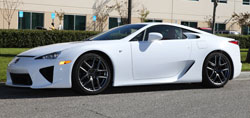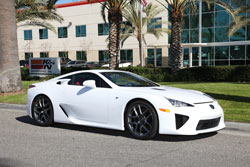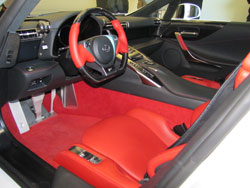2012 Lexus LFA Gets an Exclusive Four Hour Test Date with K&N's Dynamometer
- May 28, 2010
Supercars are just that - they're super - superior in every way with the transporters we commute in daily. They're tremendously faster and more powerful, created by skilled hands, not soulless robots, and they are capable of doing stuff beyond our shallow driving imaginations. Much like racecars, which falls within the genre most supercars are designed after. Every specialized nut and bolt that goes into these vehicles is put into place by a professional who takes the time and has the knowledge to manufacture something distinctively extraordinary. They are adventure and gadgetry, speed and sex-appeal, rolled into an elite work of art.
Typically, when we think supercar its Porsche Carrera GT2, Ferrari, or Lamborghini type images that color our motoring fantasies, but with the debut of the 552-horsepower 2012 LFA, Lexus intends on expanding the profundity of those dreams. With a street value of around $400,000, and the added exclusivity of only making 150 cars available in the US, there's little to doubt that they will succeed. Lexus USA owns but one LFA, a jet-black model used for advertising and potential customer events. The white one, which was offered to Motor Trend magazine for a zippy 12-hour only review, was on loan from Japan at substantial cost to the company - air freight alone was $40,000. Complicating things further is that the white one is what's referred to in industry terms as a "crusher", a preproduction prototype. It has no VIN or license plate, and rolls on non-DOT-approved tires, so testing on the street was out. To ensure the car was treated with the utmost respect at all times, two vigilant bodyguards watched over the car at all times. Yet, forlornly ironic is when it gets shipped back to Japan, it will most likely be smushed into a table lamp. Hence, the editors of Motor Trend carefully divvied up their 12-hour test allocation in order to gather the most comprehensive results. The first one-third of the evaluation stipend was spent on riding the dynamometer at K&N's R&D, with Bert Heck and the dyno crew. K&N dynos hundreds of cars a year in order to establish baseline figures and track performance of its products. This is precisely why they always function even better than advertised. Last year alone K&N cycled its dynos over 6,400 times. "We have five dynamometers total, three chassis dynos, one for powersports applications and one engine dyno," explains Heck, Performance Kit Manager for K&N. "A cycle is one pull on the dyno, once the vehicle is strapped to the dyno, we make a pull. What you do is bring the vehicle up to a certain rpm, then open the throttle wide open until it reaches a maximum rpm, then get out of the throttle, and let the vehicle come back to a idle. We let the vehicle sit for three to five minutes to get the operating temperatures back down to its normal operating range, and then it's ready to start over." After successive pulls, and un- baffling the spine-tingling, Yamaha music department tuned LFA racecar acoustics, K&N experts had their raw numbers: 447.1 horsepower, 294.5 pound-feet of torque. After SAE correction, LFA's output drops to 430.3 horsepower and 283.1 pound-feet of torque. The car's speedometer flashed 207 mph before they lifted off the gas. Motor Trend's Ed Loh, wrote, "Sure, there is no wind resistance on the dyno, but that only makes the exhaust note from the triple pipes sound that much more unholy -- like the union of a jet engine and Ducati race bike. No production V-10 has ever sounded this good." Not only did Yamaha tune the V-10's sweet notes, they designed and built the engine - a virtual race powerplant that weighs in less than a typical street V-6. The entire LFA is in fact made of 65-percent carbon-fiber reinforced polymer, that's been finished up to strict aeronautics standards. "Any doubts that the Lexus is anything but a legitimate supercar are absolutely gutted on the test tarmac. Only supercars manage to brake from 60 in under 94 feet and pull 1.05 g on the skidpad," wrote Loh. LFA stands for Lexus Fuji Apex. Fuji Speedway is the Toyota owned racetrack where the ISF and LFA performance line was born and developed. Apex simply means it's the pinnacle flagship vehicle for Lexus. After completing the four hour test at K&N Heck commented, "The car was out of control, the fit and finish of all that carbon fiber was just outstanding. Once the vehicle was on the dyno and making a pull, the engine was so smooth in the high rpm's that you could tell Lexus put a lot of engineering into this vehicle. This would be one cool car to have sitting in your garage." Find K&N products for your vehicle using the K&N application search then use the K&N dealer search to find a K&N dealer in your part of the world. |













